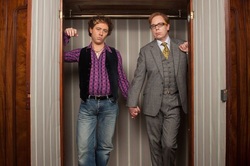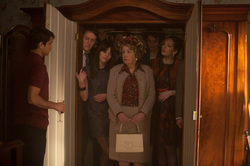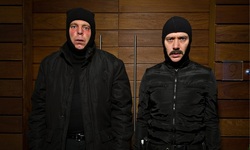
We’re now two episodes into Reece Shearsmith and Steve Pemberton’s new anthology series, Inside No. 9. Any viewers who turn in expecting another League of Gentlemen, with surrealist sketches, or even the bizarre plot of Psychoville, are going to be disappointed. Inside No. 9 owes a lot more to Roald Dahl’s Tales of the Unexpected, short, self-contained vignettes with a sting in the tail. The central concept is that each episode takes place inside one location, the titular No. 9, but beyond that, it’s anyone’s guess as to where the plot will go.

And what people to be forced to share personal space with, with stars of the small screen, big screen and stage all in one tiny cupboard. Katherine Parkinson, the only actor who remained in the scene for the entire episode, was a masterpiece of tiny frustrated tics as she attempted to make the game proceed correctly. Probably the weakest links in terms of the acting were surprisingly the creators. Pemberton mainly stood in a corner to feel uneasy and blurt out one of the twists near the end of the episode, and (possibly) could have been cut as a character without too much damage. Shearsmith’s Stu was an overdrawn caricature in comparison to the restrained performances from the rest of the cast, which was a pity. He can definitely do refined acting, as seen in his lead role in A Field in England, but Stu felt like he was in the wrong series.

The basic plot for this episode saw Pemberton and Shearsmith as two burglars breaking into a house to steal a painting, while the occupants of the house suffered through the breakdown of a relationship. Rather than episode one’s comedy of manners, this was a slapstick farce of an episode, with near misses and inconvenient dogs providing the laughs. The two creators were somehow more restrained even as they were crawling across the floor, letting the situations speak for themselves (well, so to... speak). The plot twist also worked better in this episode, possibly because the last five minutes of the story were dedicated to the ending, rather than feeling like an afterthought, as it did in episode one. It’s tempting to see the conclusion as a statement on modern art, but perhaps that’s being too unkind.
It’s exciting to wonder what the next four episodes will bring, and if the format of an expected twist ending will become stale and tired. On the basis of these two episodes, it’s some of the most tightly plotted and written television Shearsmith and Pemberton have written in years.

 RSS Feed
RSS Feed
